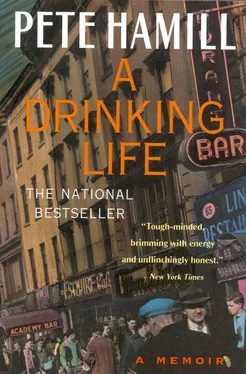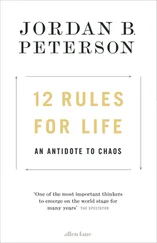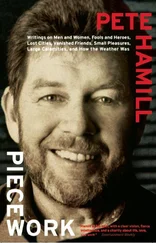I decided to jump bail and try to make it back to New York. Tim stayed behind, to work for a degree, while I shared a ride with a guy from Buffalo who was heading home. As we approached the border, I was certain that my name must be on some list. I would show my visa to the Mexican border guards and they’d see my name and start to arrest me. I rehearsed escapes: sprinting across the bridge, leaping into the shallow waters of the Rio Grande. In my mind, I heard the cracking of shots. I heard bullets whistling. I saw men fighting with bricks to possess the body of a frightened woman.
When we reached the bridge, my heart was pounding, my hands were wet. But there was no list. The guard took my visa and waved us across. The dream of Mexico-as-Paris was over. In Brownsville, we stopped for gas and I had a cold bottle of Lone Star. I looked back at Mexico, relieved and free, but overwhelmed with an almost intolerable sadness.
HOME AGAIN in New York, after nine months away, I quickly fell into the earnest rhythms of the 1950s. Necessity was the goad; I needed to eat and get on with my life. I again worked for Ernie Waivada in the advertising agency. I spent a year at Pratt, studying design. I took a small flat on the Lower East Side. After work or school, I went drinking. I wrote a little and painted less.
On one level, the track was clear. Learn a trade and you’ll never go hungry, my father said. Graphic design was a trade, like plumbing or carpentry. If I mastered it, I would never go hungry. But in truth I was hesitant about moving down the track. In magazines like Graphis, I saw the cold elegant layouts of Swiss designers and studied the bolder work of the Americans. Some of them offered more than the example of craft; they promised a vision based on order, the reduction of chaos to a small neat space. But in the art galleries, I finally saw the actual work of Kline and Pollock, de Kooning and Motherwell, stood close to their ferociously confident canvases. There was nothing cold about their disorderly art and nothing small. They had the size and boldness of the Mexican muralists but were free of their preaching. I was drawn to the physicality of their paintings, the almost athletic swagger of the brushwork. But at the same time, their work seemed beyond me, their vision too heroic. After this, where could painting go? Where could I go?
Writing remained only a perhaps. In my flat off Second Avenue, or in small dark bars, I filled notebooks with questions about art, politics, my own chaotic ambitions. Sometimes, late at night in the flat, I typed these notes on an old upright Royal I’d bought in a secondhand store and put them in file folders. I tried short stories in the Hemingway manner, more variations on what had happened to me in Mexico, even poems, transcribed from fragments scribbled in bars. But it seemed an arrogant ambition to be a writer, in a world where Hemingway and Faulkner still lived. Who do you think you are? some collective voice from the Neighborhood called to me. Who the hell do you think you are? Besides, in bars at night, or at Pratt, or at my part-time drawing table at the agency, I could still show off with a drawing. And if there was even small applause, I felt that I never could completely abandon the dream of art; the prospect filled me with dread. For a long time, I’d based my identity on the hope of being an artist; to give up now might cast me into the shapeless fog that had engulfed me after the failure at Regis.
I carried these confusions with me through a New York terrain now permanently changed by the tubular Ben Shahn forests of television antennas and highways leading to the faceless Levittowns of Long Island. The Neighborhood, its streets already emptied at night by television, began to reel from departures to the new suburbs and the arrival of the plague of heroin. When I visited 378, my mother talked for the first time about danger. Standing with my father at the bar in Rattigan’s, a full member now of the fraternity, I heard about muggings and overdoses. A few men died of cirrhosis from drinking, but compared to a needle in the arm, that was an honorable death. In tenements where once there was nothing much worth stealing, people now started locking their doors.
The Eisenhower era bragged of the good life for all, a time of abundance and prosperity, but it didn’t touch the Neighborhood. The prosperous were gone to the suburbs; among those who stayed, money was still short. Everywhere in the city, factories were closing. Globe Lighting, where my father worked, moved from the Neighborhood to Flushing and then, later, to Georgia. In the daytime, there were more men in the bars, drinking in silence and defeat. The city was changing: gradually, almost imperceptibly in some ways, drastically in others. The world wasn’t as solid as it seemed when I was twelve; and that was a confusion. You spent twenty years learning how to live in the world and then it changed on you. I’d wake up some mornings and buy the newspapers and think: What the fuck is going on?
Even in bars, some things were not discussed. McCarthy was gone, but the Great Fear had left its mark. At the agency, I was on the fringe of the world of organization men, men in gray flannel suits, men who talked about the new cult of motivation research, of inner-directed and outer-directed human beings, of lonely crowds and hidden persuaders. They shrugged when you mentioned politics (although Ernie Waivada, from Massachusetts, was a huge fan of Senator Jack Kennedy). Politics was trouble. Get the money. Or get the women. Luscious secretaries from Lynbrook. Sweet fearful file clerks from the Bronx. Noble defenders of the holy hymen. But willing to please at the midnight hour. I knew I couldn’t exist for long in that world. Painter or writer, I needed to be free.
In the fall of 1957, Jack Kerouac’s On the Road was published by Viking Press, with a glowing review by Gilbert Milstein in the New York Times. I went out and bought a copy, that first hardcover edition with the famous photograph of Kerouac in rough lumberjack shirt and silver crucifix, his eyes brooding, his square fullback’s face unshaven. I read the first sentence on the subway to Brooklyn — I first met Dean not long after my wife and I split up — and was carried away. I read in the Village Voice (then three years old and full of surprises) that Kerouac was due in town for a Friday-night jazz-poetry reading at the Village Vanguard. I paid the admission, went downstairs, ordered vodka at the bar, and for almost two hours listened to Kerouac, Gregory Corso, and some other poets. I was thrilled with the flow of words and the counterpoint of jazz, and gazed through the cigarette smoke at the remote women, who all seemed dressed in black, cool as ice sculpture. Kerouac was older than I expected (he was then thirty-five) and punched out with his hands to punctuate his lines. At the end, the audience cheered. I wanted to talk to him, about Mexico and Pensacola and jail and women; but I couldn’t get close to him when it was over; he was engulfed by reporters and photographers and the cool dark women. That year, Jack Kerouac was a star.
I went back upstairs into Seventh Avenue and wandered east to University Place and eased into the packed bar of the Cedar Street Tavern, where the painters did their drinking. For an hour, I drank beer alone at the bar and listened to an argument over centerfielders. Suddenly Kerouac and his friends came in, shouldering through the door, then merging with the other drinkers, three deep at the bar. Kerouac edged in beside me. He was drunk. He threw some crumpled bills on the bar. I said hello. He looked at me in a suspicious, bleary way and nodded. The others were crowding in, yelling, Jack, Jack, and he was passing beers and whiskeys to them, and Jack, Jack, he bought more, always polite, but his eyes scared, a twitch in his face and a sour smell coming off him in the packed bar that reminded me of the morning odor of my father in the bed at 378. Soon he was ranting about Jesus and nirvana and Moloch and bennies, then lapsing into what sounded like Shakespeare but probably wasn’t, because his friends all laughed. Under the combination of Kerouac and beer, my brain was scrambling. The painters gave him a who-the-fuck-is- this -guy? look. College girls were coming over. A bearded painter bumped him on the way to the bathroom and Corso let out a wail of protest at the ceiling and the bartender looked nervous and soon I was drunk too.
Читать дальше












